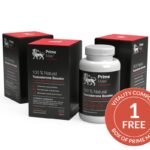As a Strength Coach and a Personal Trainer for 15 years, I’ve had a chance to see many fitness enthusiasts workout at many gyms in my local area and throughout the country. At any given gym or fitness center, the one thing that I notice is how you see the same people doing the same workouts month after month, year after year. The amazing thing is that these people continue to look the same or they are actually looking worse aesthetically. This is especially true with the constant performance of continuous aerobic work.
What’s sad about this is that they feel like they are doing everything necessary to get the result they are looking for. They are resigned to the fact that this is how it’s going to be and there isn’t anything that can be done to correct their deficiencies. If you were to ask them what results from they would like to get out of their workout, the number 1 answer is “losing weight or getting thinner.”
When I am asked what it takes to look “fitter,” the first question I ask is: “How long have you been doing your current training program?”
The usual answer I receive is “somewhere between 6 and 12 months.” The typical program they follow is “30 – 60 minutes of continuous aerobic work 3 to 5 times per week.”

Our training tells us that this is not a good approach to take for the client seeking improving results over time. World-renowned strength guru Charles Poliquin has identified 6 reasons why aerobic training is counterproductive to fat loss:
Continuous aerobic work plateaus after 8 weeks of training do anything more is counterproductive.
This is quite an “eye-opener” for most people who immediately recognize that they may have been wasting their time for such an extended period. To quote Charles, “using this principle in preparation for the 92 Olympics, the Canadian Alpine Ski team actually surpassed the Cross-country team on aerobic scores as measured by third-party University labs.” Who wouldn’t want to perform as well as the Canadian Alpine ski team?
Aerobic training worsens power locally and systemically – in other words, it can make you slower.
If you are an athlete or a “weekend warrior” who likes to participate in athletic events or team sports that require speed and jumping ability, this is the last thing you want from a cardiovascular training program. Coach Poliquin adds that “the more lower body aerobic work you do, the more your vertical jump worsens. The more upper body aerobic work you do, the more your medicine ball throws worsen.”
Aerobic training increases oxidative stress which can accelerate aging.
According to Endocrinologist Dr Diana Schwarzbein (author of The Schwarzbein Principle II ,) “oxidation” is a process that forms free radicals in the body. Normally the body can neutralize free radicals with substances known as antioxidants. It is only when there is an excessive build-up of free radicals that the body cannot neutralize all of the free radicals. This leads to changes to your metabolism which can accelerate ageing.
Aerobic training increases adrenal stress which can make you fatter and produce other undesirable health consequences
According to Dr. James Wilson (author of Adrenal Fatigue – The 21st. Century Stress Syndrome,) “normally functioning adrenal glands secrete minute, yet precise and balanced, amounts of steroid hormones”. When one does too much continuous aerobic exercise, the adrenal glands are stressed in a way that can upset this delicate balance which could lead to adrenal fatigue. Adrenal fatigue is associated with such symptoms as: tiredness, fearfulness, allergies, frequent influenza, arthritis, anxiety, depression, reduced memory, and difficulties in concentrating, insomnia, feeling worn-out, and most importantly- with respect to this article – the inability to lose weight after extensive efforts.”
Aerobic training increases body fat in stressed individuals by contributing to additional stress.
If you are already going through a lot of stress in your life then adding more “stress” by doing too much continuous aerobic work will actually add more body fat thus making it hard to reach a weight-loss/body fat goal.
Aerobic training worsens testosterone/cortisol ratio which impedes your ability to add fat burning lean muscle.
When the testosterone/cortisol ratio is lowered your ability to add lean muscle tissue, which helps to increase caloric expenditure, is again hampered making weight loss much more difficult. Coach Poliquin notes that “continuous aerobic work is basically exercise induced castration!”
Alternative strategy for training the cardiovascular system
I provided six reasons why continuous aerobic work is counterproductive to your training. My purpose was to enlighten a population that has been led to believe that there is only one way to train the cardiovascular system.
In this second part, I will provide trainees with an alternative strategy for training the cardiovascular system that is more effective and takes less time to complete.
The Question of Body Fat
I often ask my clients, “who has less body fat, a Sprinter or a Marathoner?” The answer I receive is almost always “a Marathoner.”
The correct answer, however, is a sprinter! (In 15 years of training, only two people have answered this question correctly!). You can understand why, since the general public has been told over and over again that in order to burn fat you have to do continuous aerobic work. Sprinters do almost ZERO continuous aerobic work, yet they have less body-fat. How is this possible?
The reason is rooted in the intense nature of their training. The higher the intensity (i.e. “Intensity” is the percentage of the Maximum Heart Rate, not the intensity of effort) the more calories per minute burned during the workout. In addition (and more important,) caloric expenditure is increased for 24-48 hours post-workout.
The Power of Interval Training
The way for individuals to raise the intensity of their training is to do “Interval Training.” Interval Training alternates bouts of high-intensity exercise with that of low to moderate-intensity exercise. Recent studies have shown that Interval Training is more effective for fat loss while improving both Aerobic and Anaerobic fitness.
Tabata et al. (1) compared a 70% of VO2 max moderate-intensity group (MIG) vs. a high-intensity interval group (HIIT). The MIG group did increase their VO2 max by about 10% without a concurrent improvement in anaerobic capacity. The HIIT group improved their VO2 max by 14% and their anaerobic capacity by 28%. The HIIT group actually improved both anaerobic and aerobic capacity at the same time!
Tremblay et al. (2) compared a sprint ergometer group versus an aerobic group. Despite burning 50% less calories, the sprint group lost three times more fat than the aerobic group.
A sample Interval Protocol for Fat Loss
As always, please check with your physician before embarking on any intense exercise program.
Table 1:
| Workout(s) |
Sets |
High Intensity |
Low Intensity |
|
1 & 2 |
6 |
40 Sec. |
2:00 |
|
3 & 4 |
7 |
40 Sec. |
2:00 |
|
5 & 6 |
8 |
40 Sec. |
2:00 |
|
7 & 8 |
9 |
40 Sec. |
2:00 |
|
9 & 10 |
10 |
40 Sec. |
2:00 |
|
11 & 12 |
11 |
40 Sec. |
2:00 |
|
13 & 14 |
12 |
40 Sec. |
2:00 |
|
15 & 16 |
12 |
45 Sec. |
1:45 |
|
17 & 18 |
12 |
45 Sec. |
1:30 |
- Perform 2-3 sessions/week on non-consecutive days
- Before embarking on Workout 1, take a practice workout or two to establish the fastest possible speed for the “High Intensity” sets. This is very important to elicit the proper hormonal response.
If a preparatory phase is needed before embarking on the above Interval program in table 1, follow the workouts in table 2:
Table 2:
| Workout(s) |
Sets |
High Intensity |
Low Intensity |
|
1 |
4 |
40 Sec. |
4:00 |
|
2 |
4 |
40 Sec. |
3:45 |
|
3 |
4 |
40 Sec. |
3:30 |
|
4 |
5 |
40 Sec. |
3:15 |
|
5 |
5 |
40 Sec. |
3:00 |
|
6 |
5 |
40 Sec. |
2:45 |
|
7 |
6 |
40 Sec. |
2:30 |
|
8 |
6 |
40 Sec. |
2:15 |
* Perform 2-3 sessions/week on non-consecutive days
For those of you who are in the general public and have not exercised in years do the following protocol:
Table 3:
| Phase |
Time |
Heart Rate |
Weeks |
|
1 |
Work up to 45 minutes |
60 % of THR* |
1 – 3 |
|
2 |
20 minutes |
80 % of THR |
4 – 6 |
- Perform 3-4 sessions/week
- THR = Target Heart Zone
- Do not do more than six weeks of Table 3 workouts. I repeat – do not do more than six weeks of Table 3!
After completing the 2 phases in table 3, move on to table 2 interval workouts to prepare for the interval workouts in table 1.
After completing the 18 workouts in table 1, a new cycle can be started at higher initial speed during the “High Intensity” sets.
For an individualized Interval Training program contact your local PICP certified professional. Most of all enjoy the burn!
1. Tabata, I., Irishawa, K., Kuzaki, M., Nishimura, K., Ogita, F., and Miyachi, M., Metabolic Profile of High-Intensity Intermittent Exercises. Medicine & Science in Sports & Exercise, 29(3), 390-395, 1997).
2. Tremblay, A., J. Simoneau, and C. Bouchard, Impact of Exercise Intensity on Body Fatness and Skeletal Muscle Metabolism. Metabolism.43:814-818, 1994.
The Original Author Of This Article Is The One And Only The Master Charles Poliquin Rest In Peace Brother






Leave a Reply